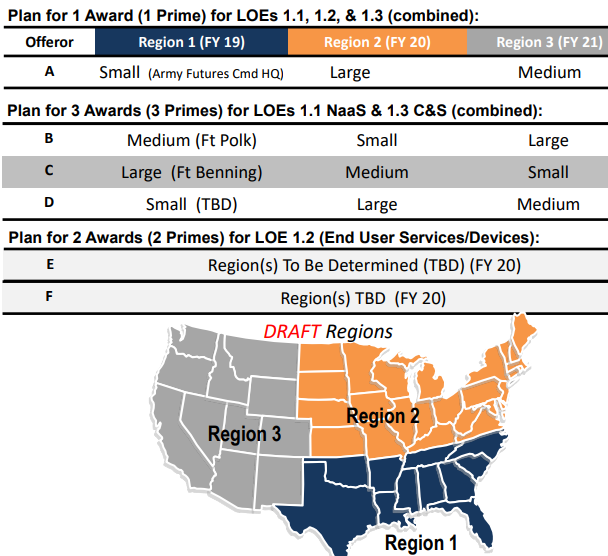Army to Flex OTA Powers to Acquire Enterprise IT as a Service
The U.S. Army is planning to use its “other transaction” authority, or OTA, to fast-track six contracts for enterprise information technology services at close to 300 bases around the country, according to Pentagon officials.
The Army’ Program Executive Office for Enterprise Information Systems, or PEO EIS, held an industry day for its Enterprise Information Technology as a Service, or EITaaS, initiative May 7 at Fort Belvoir, Virginia, where Army officials outlined the department’s vision for delivering secure network infrastructure, computing power, storage, hardware, software, and IT services using commercial best practices.
“We are using the OTA process to do the prototyping of how to execute EITaaS more rapidly,” Tara Clements, a PEO EIS spokesperson, said in an email. “The flexibility that the OTA process provides us in refining requirements will be invaluable in getting the process right.”
According to an industry day presentation, PEO EIS proposed issuing a total of six OTA awards to support three distinct lines of effort, or LOEs:
- 1.1 Network as-a-Service (NaaS) – Wired, wireless, and satellite communications services with industry standard encryption and virtual desktop infrastructure.
- 1.2 End-User Services and Devices (EUS) – Provision and servicing of end-user laptops, desktops, mobile devices, and printers.
- 1.3 Compute and Store (C&S) – Collaborative data environment with global access to data, analytics and shared data protection.
The current plan calls for making four awards by the end of August 2019 and two more in fiscal 2020. The first prototype projects will begin at Army installations in the southern U.S.: Army Futures Command Headquarters in Austin, Texas, Fort Polk in Louisiana, and Fort Benning in Georgia. In fiscal 2020 and 2021, the Army will scale these capabilities at bases in the American Midwest and Northeast, followed by those in the Mountain West and along the Pacific Coast. However the Army may revise th at schedule based on industry feedback.
Army EITaaS Draft Acquisition Approach

Army PEO EIS
In total, 176 companies attended the May 7 industry day. That included most of the federal government’s top IT contractors, such as General Dynamics Corp., Leidos Holdings Inc., Perspecta Inc., Northrop Grumman Corp., and CACI International Inc. Also in attendance were all five of the top U.S. cloud computing providers, Amazon Web Services Inc., Microsoft Corp., Google Inc., Oracle Corp., and International Business Machines Corp.
“We’re looking for transformational approaches and we’re interested in all ideas from all vendors,” Clements said. “Our team has leveraged lessons learned from the joint service and interagency partners and we’re committed to encouraging feedback from industry to further inform our acquisition approach.”
To OTA, or Not to OTA?
The Army’s move mirrors the EITaaS playbook developed by the U.S. Air Force’s Electronic Systems Center, which in fiscal 2018 issued two OTA agreements for NaaS “experiments” worth $87 million and $34 million, respectively, to AT&T Inc. and Microsoft. If that’s the case, each of the six OTA awards the Army plans to issue could be worth $25 million to $100 million or more.
OTAs were designed to enable select federal agencies to expedite funding for research and development and prototyping projects, especially when nontraditional suppliers are involved. Compared with working through the traditional procurement process, OTAs can be awarded faster, they typically involve less red tape, and they are harder to challenge in court.
But according to Clements, the Army plans to use OTAs for only the pilot phase of the program. “Once we’ve completed the prototypes, the implementation phase would most likely be done through FAR contracting with competition,” she said.
“OTAs are just one tool in the procurement playbook,” said Roger Waldron, president of the Coalition for Government Procurement. “It will be interesting to see what unique capabilities the Army can get access to using OTA, and it’ll be important to follow how the program transitions to the FAR process.”
The Pentagon’s use of OTA has risen sharply since the department received permanent authority in the fiscal 2016 National Defense Authorization Act. Since fiscal 2016, total Pentagon spending via OTAs has almost tripled, from $1.4 billion to $2.1 billion in fiscal 2017 to just shy of $4 billion in fiscal 2018.
Defense agencies have already spent $2.1 billion through OTAs in the first four months of fiscal 2019 (Oct. 1 to Feb. 7, the most recent day for which data is available, due to the Pentagon’s 90-day reporting lag).
Chris Cornillie is a federal market analyst with Bloomberg Government.
To contact the analyst: Chris Cornillie in Washington at ccornillie@bgov.com
To contact the editors responsible for this story: Daniel Snyder at dsnyder@bgov.com; Jodie Morris at jmorris@bgov.com